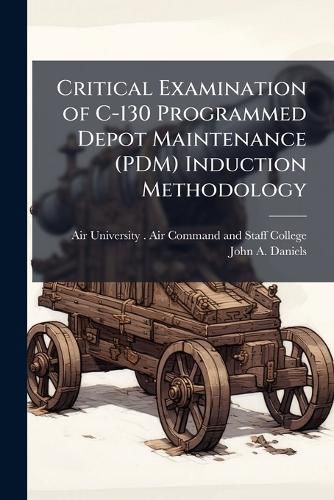Readings Newsletter
Become a Readings Member to make your shopping experience even easier.
Sign in or sign up for free!
You’re not far away from qualifying for FREE standard shipping within Australia
You’ve qualified for FREE standard shipping within Australia
The cart is loading…






This title is printed to order. This book may have been self-published. If so, we cannot guarantee the quality of the content. In the main most books will have gone through the editing process however some may not. We therefore suggest that you be aware of this before ordering this book. If in doubt check either the author or publisher’s details as we are unable to accept any returns unless they are faulty. Please contact us if you have any questions.
The current USAF process for establishing intervals between C-130 PDM does not account for the wide range of aircraft variables within each aircraft MDS. This paper develops an analytical model, based on five unique aircraft variables, to provide C-130 maintainers with a prediction tool to forecast when a C-130 aircraft requires PDM. These five variables include: aircraft age, total flying hours, average yearly flying hours, mission profile (expressed as a severity factor), and operating location of the aircraft. Interviews with C-130 SPO personnel, combined with use of the C-130 Service Life Data Base, provided the required data to develop the C-130 PDM interval model.The C-130 PDM interval model developed in this paper allows maintainers and operators to predict the optimum time between C-130 PDM activities. It eliminates the requirement to base PDM intervals on aircraft MDS. As a result, there is a potential for significant savings by deferring PDM for a portion of the C-130 fleet. Finally, the PDM interval model developed in this paper may be applicable for other DOD aircraft which use aircraft MDS as the determinant of PDM intervals.
This work has been selected by scholars as being culturally important, and is part of the knowledge base of civilization as we know it. This work was reproduced from the original artifact, and remains as true to the original work as possible. Therefore, you will see the original copyright references, library stamps (as most of these works have been housed in our most important libraries around the world), and other notations in the work.
This work is in the public domain in the United States of America, and possibly other nations. Within the United States, you may freely copy and distribute this work, as no entity (individual or corporate) has a copyright on the body of the work.
As a reproduction of a historical artifact, this work may contain missing or blurred pages, poor pictures, errant marks, etc. Scholars believe, and we concur, that this work is important enough to be preserved, reproduced, and made generally available to the public. We appreciate your support of the preservation process, and thank you for being an important part of keeping this knowledge alive and relevant.
$9.00 standard shipping within Australia
FREE standard shipping within Australia for orders over $100.00
Express & International shipping calculated at checkout
Stock availability can be subject to change without notice. We recommend calling the shop or contacting our online team to check availability of low stock items. Please see our Shopping Online page for more details.
This title is printed to order. This book may have been self-published. If so, we cannot guarantee the quality of the content. In the main most books will have gone through the editing process however some may not. We therefore suggest that you be aware of this before ordering this book. If in doubt check either the author or publisher’s details as we are unable to accept any returns unless they are faulty. Please contact us if you have any questions.
The current USAF process for establishing intervals between C-130 PDM does not account for the wide range of aircraft variables within each aircraft MDS. This paper develops an analytical model, based on five unique aircraft variables, to provide C-130 maintainers with a prediction tool to forecast when a C-130 aircraft requires PDM. These five variables include: aircraft age, total flying hours, average yearly flying hours, mission profile (expressed as a severity factor), and operating location of the aircraft. Interviews with C-130 SPO personnel, combined with use of the C-130 Service Life Data Base, provided the required data to develop the C-130 PDM interval model.The C-130 PDM interval model developed in this paper allows maintainers and operators to predict the optimum time between C-130 PDM activities. It eliminates the requirement to base PDM intervals on aircraft MDS. As a result, there is a potential for significant savings by deferring PDM for a portion of the C-130 fleet. Finally, the PDM interval model developed in this paper may be applicable for other DOD aircraft which use aircraft MDS as the determinant of PDM intervals.
This work has been selected by scholars as being culturally important, and is part of the knowledge base of civilization as we know it. This work was reproduced from the original artifact, and remains as true to the original work as possible. Therefore, you will see the original copyright references, library stamps (as most of these works have been housed in our most important libraries around the world), and other notations in the work.
This work is in the public domain in the United States of America, and possibly other nations. Within the United States, you may freely copy and distribute this work, as no entity (individual or corporate) has a copyright on the body of the work.
As a reproduction of a historical artifact, this work may contain missing or blurred pages, poor pictures, errant marks, etc. Scholars believe, and we concur, that this work is important enough to be preserved, reproduced, and made generally available to the public. We appreciate your support of the preservation process, and thank you for being an important part of keeping this knowledge alive and relevant.